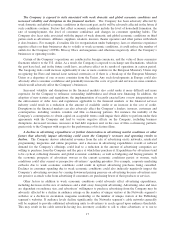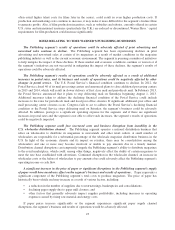Time Magazine 2012 Annual Report Download - page 38
Download and view the complete annual report
Please find page 38 of the 2012 Time Magazine annual report below. You can navigate through the pages in the report by either clicking on the pages listed below, or by using the keyword search tool below to find specific information within the annual report.television services may experience a lack of growth or declines in subscribers. In addition, if affiliates reduce
their marketing efforts associated with the segment’s premium pay television services, choose to promote their
own movie and television programming or on-demand offerings in lieu of the segment’s premium pay television
services or change the programming packages that contain the segment’s networks and premium pay televisions
services, the number of subscribers to such networks and services could decline. A decrease in the number of an
affiliate’s subscribers or the number of subscribers to the segment’s networks and premium pay television
services could result in a decrease in subscription revenues, as well as a decrease in advertising revenues for the
segment’s advertising-supported networks.
Service disruptions or the failure of communication satellites or transmitter facilities used by the
Networks segment could harm the businesses in the segment or have a negative impact on their
revenues. The Networks segment uses communication and transmitter facilities to transmit its programming to
affiliates. Currently, there are a limited number of communications satellites available for the transmission of
programming. These satellites and facilities are critical to the segment’s ability to deliver its programming, and
shutdowns or service disruptions pose significant risks to the segment’s businesses and their reputations. Such
events may be caused by power outages, natural disasters (including extreme weather), terrorist attacks, failures
or impairments of communications satellites or on-ground uplinks or downlinks used to transmit programming,
or other similar events.
RISKS RELATING TO TIME WARNER’S FILM AND TV ENTERTAINMENT BUSINESSES
Sales of DVDs have been declining, which may adversely affect Warner Bros.’ growth prospects and
results of operations. Several factors are contributing to an industry-wide decline in DVD sales both
domestically and internationally, which has had an adverse effect on Warner Bros.’ results of operations. These
factors include challenging economic conditions, the maturation of the standard definition DVD format, piracy,
intense competition for consumer discretionary spending and leisure and entertainment time, the declining
popularity of catalog titles and declining price points. In addition, consumers are increasingly obtaining content
through subscription rental (including SVOD services) and discount rental kiosks, both of which generate
significantly less revenue for Warner Bros. than DVD sales. Warner Bros.’ efforts to offset the decline in DVD
sales (e.g., Blu-ray Disc sales, sales of digital copies of feature films and establishing longer rental windows) and
its efforts to make digital ownership of films more compelling to consumers may not be successful or it may be
several years before consumers accept these offerings.
A decrease in demand for television programming could adversely affect Warner Bros.’
revenues. Warner Bros. is a leading supplier of U.S.-produced scripted television programming as well as a
leader in distributing U.S.-produced episodic programming overseas. Warner Bros. continues to be largely
dependent on the strength of the U.S. broadcast and cable networks and their demand for Warner Bros.’
television programming. If there is a decrease in the demand for Warner Bros.’ television programming, it could
reduce the number of new television series launched each year, decrease the overall scale of Warner Bros.’
television business or diminish the per-episode license fees generated by programming in initial broadcast
windows and in subsequent syndication windows. Furthermore, vertically integrated networks could elect to buy
more shows from their in-house production studios, driven in part by their desire to have more control over
digital rights. Additionally, Warner Bros.’ television series that are already on the air may fail to meet ratings
expectations, leading to their cancellation. This may be caused by individual series failing to achieve anticipated
levels of popularity with intended audiences or by audience fragmentation. Local television stations may also
face decreasing viewership that would adversely impact their advertising revenues. This could harm Warner
Bros.’ ability to obtain the per-episode license fees in syndication that it has received in the past. In international
territories, the increasing popularity of locally originated television and theatrical content could result in
decreased demand, fewer available broadcast slots, and lower licensing and syndication revenues for
U.S. television content. In addition, the consolidation of pay television content providers in international
territories has provided them greater negotiating power, which may result in lower licensing fees.
If the costs of producing and marketing feature films continue to increase, it may be more difficult for
feature films to generate profits. The production and marketing of feature films is very expensive and the cost
has increased in recent years. The trend toward producing more event films, including franchise films (which
22
























